
Thelymitra aristata, commonly called the great sun orchid, is a species of orchid that is endemic to south-eastern Australia. It has a single large, thick leaf and bracts and up to forty crowded blue or purplish flowers with darker veins.
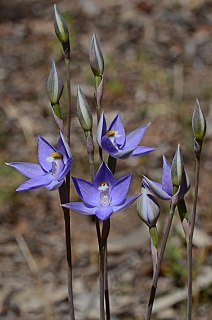
Thelymitra alcockiae, commonly called Kath's sun orchid, is a species of orchid that is endemic to southern continental Australia. It has a single long, narrow leaf and up to twelve pale blue to deep purplish blue flowers, mauve or reddish on their back side.
Thelymitra imbricata, commonly called the broad sun orchid, is a species of orchid that is endemic to Tasmania. It has a single erect, channelled leaf and up to fifteen or more pale to dark or purplish blue, relatively large flowers.
Thelymitra albiflora, commonly called the white sun orchid, is a species of orchid that is endemic to South Australia. It has a single erect, narrow, fleshy leaf and up to ten relatively small white flowers with white toothbrush-like tufts on top of the anther.
Thelymitra angustifolia, commonly known as the long-leaved sun orchid is a species of orchid that is endemic to eastern Australia. It has a single erect, thin, channelled leaf and up to ten purplish blue flowers with white tufts on top of the anther. The flowers are self-pollinating.
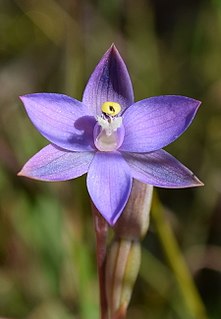
Thelymitra arenaria, commonly called the forest sun orchid, is a species of orchid that is endemic to south-eastern Australia. It has a single long, narrow leaf and up to sixteen purplish self-pollinating flowers which only open on hot days.
Thelymitra bracteata, commonly called the leafy sun orchid or large-bracted sum orchid, is a species of orchid that is endemic to south-eastern Australia. It has a single leathery, more or less flat leaf and up to thirty pale blue flowers that are greenish on the back. The bracts are larger than on similar sun orchids.
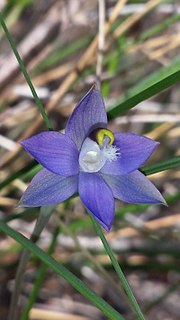
Thelymitra brevifolia, commonly called the peppertop sun orchid or short-leaf sun orchid, is a species of orchid that is endemic to south-eastern Australia. It has a single erect, relatively short and broad, dark green leaf and up to twenty purplish or purplish blue flowers. It is a common and widespread self-pollinating species occurring in a wide range of habitats.
Thelymitra exigua, commonly called the short sun orchid, is a species of orchid that is endemic to south-eastern Australia. It has a single fleshy, channelled, dark green leaf and up to eight relatively small pale blue flowers with white toothbrush-like tufts on top of the anther.

Thelymitra granitora, commonly called the coastal granite sun orchid or coastal sun orchid, is a species of orchid in the family Orchidaceae and is endemic to the south-west of Western Australia. It has a single short, curved and channelled dark green leaf and up to eight relatively large pale blue or white, self-pollinating flowers with white mop-like tufts on the top of the anther.

Thelymitra holmesii, commonly called the blue star sun orchid, is a species of orchid that is endemic to south-eastern Australia. It has a single long, narrow, fleshy leaf and up to nine purplish blue to mauve flowers with a deeply notched lobe on top of the anther.
Thelymitra pallidiflora, commonly called the pale sun orchid, is a species of orchid that is endemic to Victoria. It has a single erect, channelled, leaf and up to ten white to very pale blue, self-pollinating flowers which only open on hot days.
Thelymitra viridis, commonly called the green sun orchid, is a species of orchid that is endemic to Tasmania. It has a single erect, fleshy, channelled leaf and up to seven small self-pollinating pale blue to pale purplish flowers. The rest of the plant is a pale green colour.
Thelymitra silena, commonly called the madonna sun orchid, is a species of orchid that is endemic to Tasmania. It has a single thick, fleshy, channelled leaf and up to fifteen pale blue flowers with an almost spherical yellow lobe on top of the anther.
Thelymitra sparsa, commonly called the wispy sun orchid, is a species of orchid that is endemic to Tasmania. It has a single erect, fleshy leaf and up to six relatively small blue flowers with a few small darker spots. The flowers are self-pollinated and open only slowly on hot days. The species is restricted to a few restricted montane sites in south-eastern Tasmania.
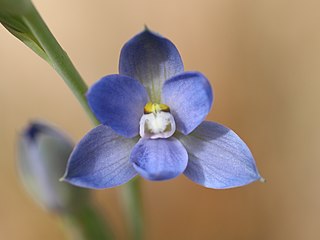
Thelymitra improcera, commonly called the coastal sun orchid, is a species of orchid that is endemic to south-eastern Australia. It has a single erect, fleshy leaf and up to eight relatively small pale to bright blue flowers on a short flowering stem. The lobe on top of the anther is unusually short and lobed.
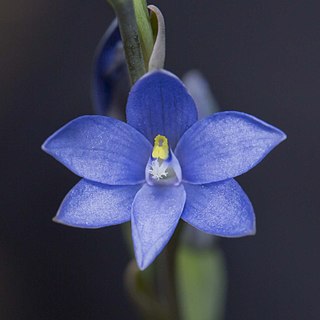
Thelymitra longiloba, commonly called the lobed sun orchid, is a species of orchid that is endemic to south-eastern Australia. It has a single erect, fleshy, channelled leaf and up to six relatively small blue flowers with side lobes above the anther. Although widespread, it only occurs in disjunct populations and is classed as "endangered".
Thelymitra erosa, commonly called the striped sun orchid, is a species of orchid that is endemic to Tasmania. It has a single erect, fleshy dark green leaf and up to eight moderately large dark blue to purplish or pink flowers with darker veins. The column arms have irregular lobes.
Thelymitra atronitida, commonly called the black-hooded orchid, is a species of orchid that is endemic to south-eastern Australia. It has a single erect, leathery, leaf and up to eight moderately dark blue, self-pollinating flowers that only open on hot days.
Thelymitra × truncata, commonly called the truncate sun orchid, is a species of orchid that is endemic to south-eastern Australia. It has a single tapering, more or less flat leaf with a reddish base and up to six blue, pink or white flowers with a tube-shaped lobe on top of the anther. It is a natural hybrid between a range of species, including T. pauciflora and T. ixioides.







